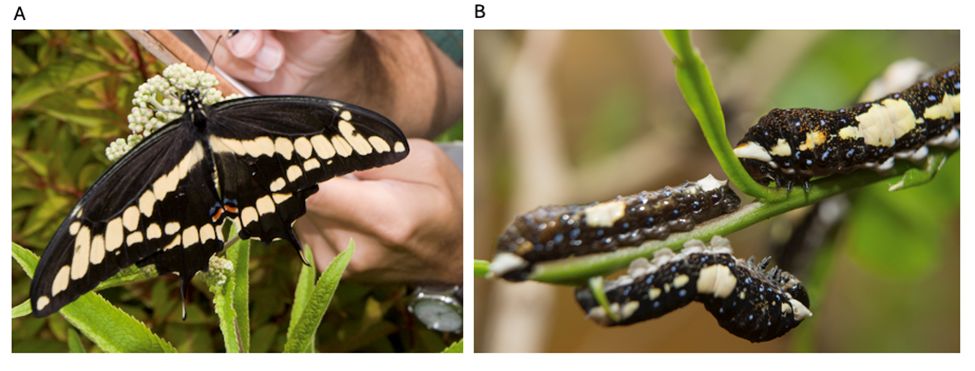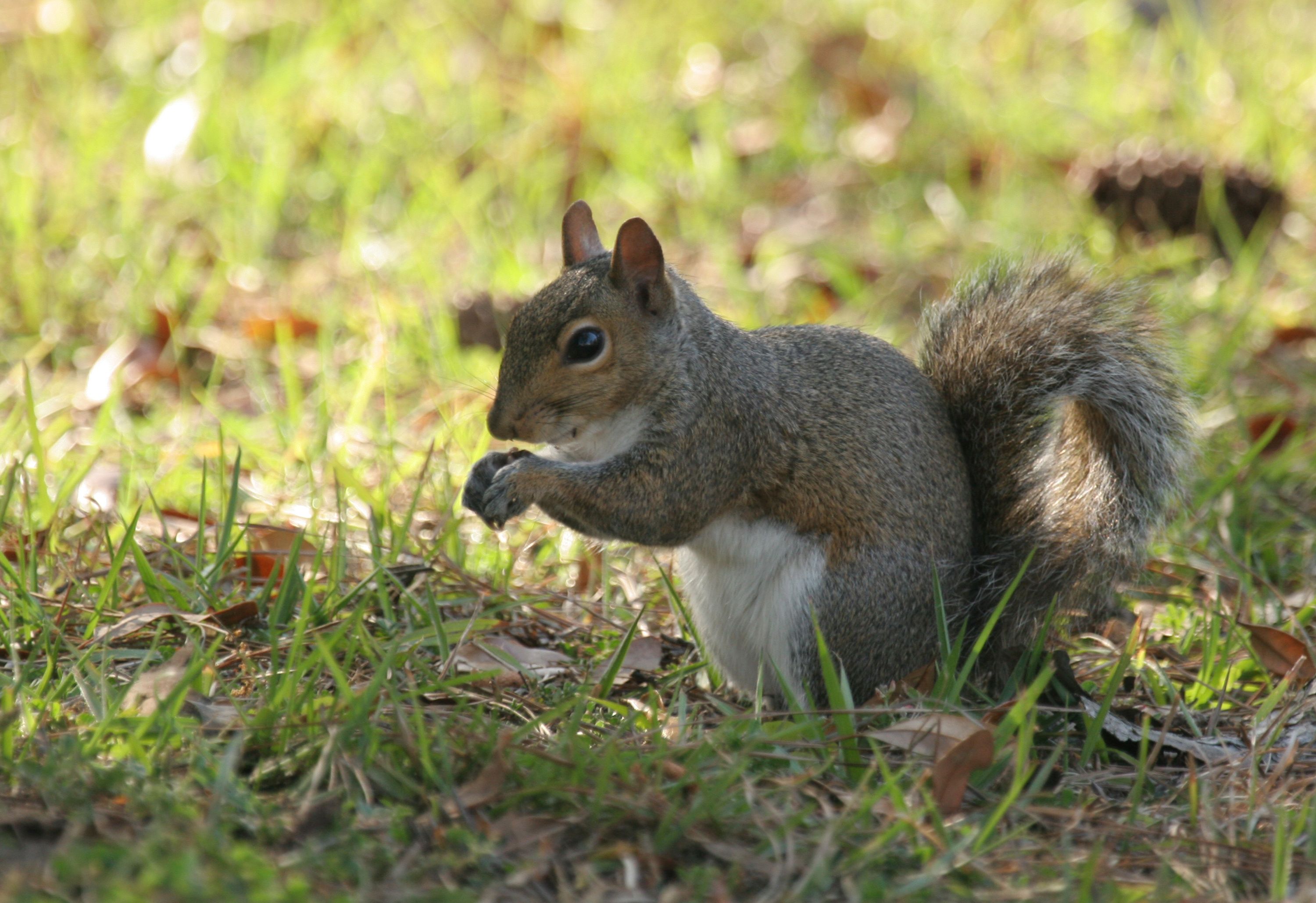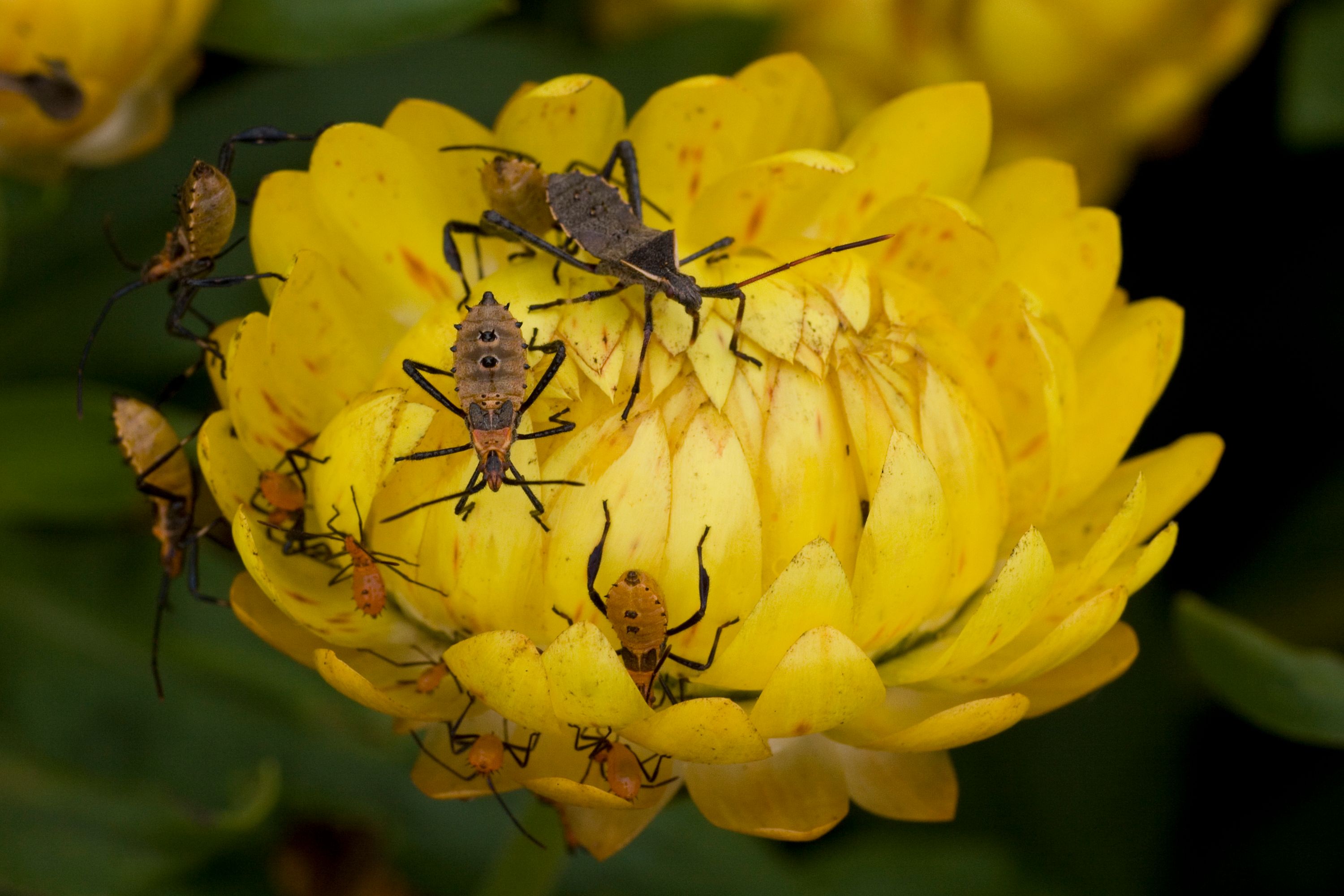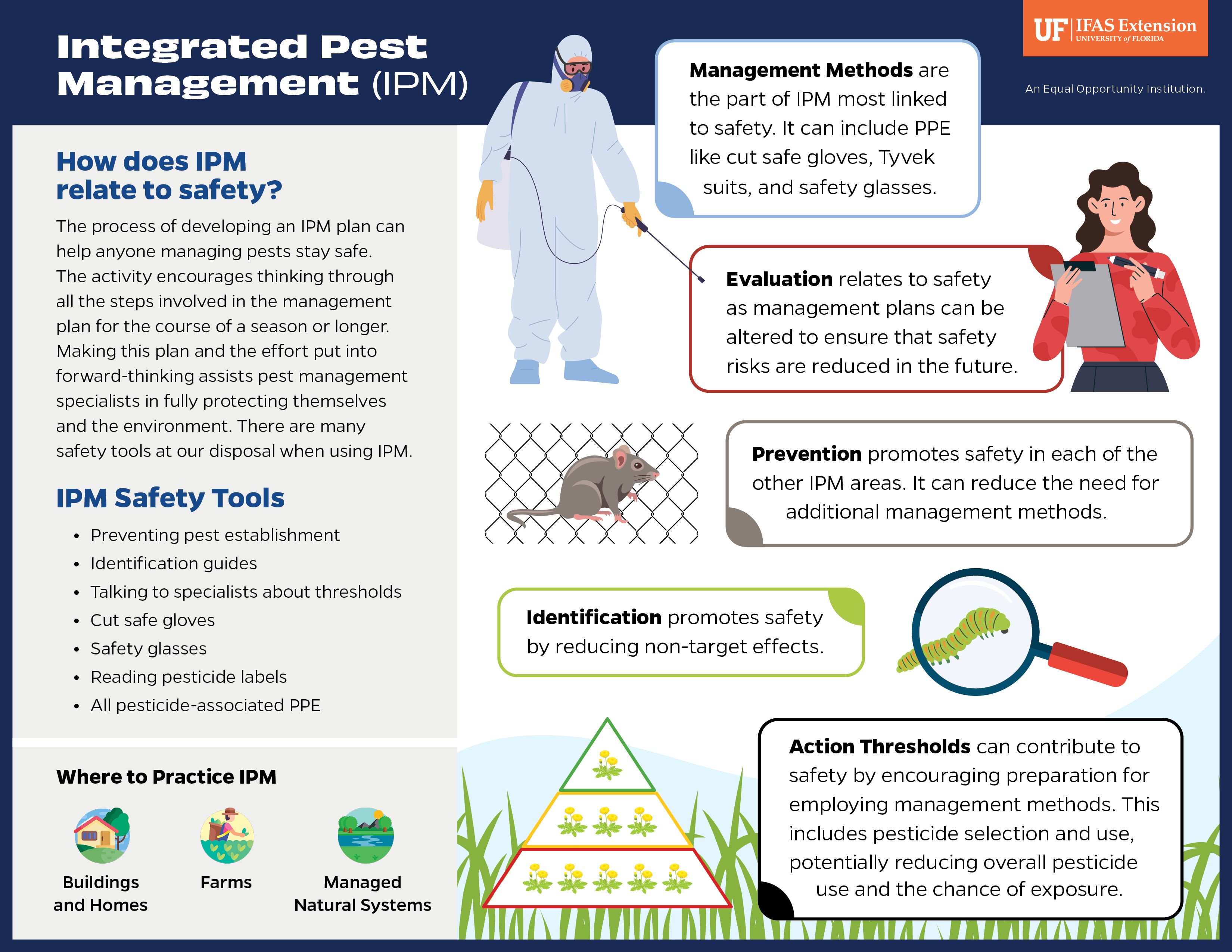This publication is geared toward certified pesticide applicators and homeowners who are managing indoor and outdoor pests. It provides a broad definition of a pest and generally describes integrated pest management (IPM) and pest management strategies. It also emphasizes the use of IPM to reduce the development of pesticide resistance and how IPM contributes to personal and environmental safety. As opposed to other EDIS publications which are specific to management areas (e.g., landscape, turf, vegetables), this publication can be used as a base for all sectors of pest management and uniquely promotes the link between IPM and safety.
What is a Pest?
A pest can be considered any organism that negatively affects humans or human interests. Examples include negative effects on agriculture, human health, recreation, and the economy. An organism can be considered a pest on a case-by-case basis. Some things are nearly always considered to be pests, such as mosquitos in the backyard or flies in the kitchen. This is largely due to the ability of these insects to transmit disease. In other cases, organisms are considered pests because they are in the wrong place at the wrong time. For example, a butterfly may be a welcome visitor in a butterfly garden; however, it can be a pest if the caterpillars are feeding on a crop like citrus, dill, or passionfruit (Figures 1A and 1B). Therefore, the status of being a “pest” is up to the individual managing the home or garden and based upon the specific situation and even personal preferences. Pests may come from any of several major groups including insects, pathogens, nematodes, plants (invasive species, weeds), or vertebrates (things with a backbone).

Credit: Tyler Jones, UF/IFAS
Integrated Pest Management
When pests are present, management is essential to protect human interests. Integrated Pest Management (IPM) involves developing a long-term and sustainable plan for managing those pests, using a combination of strategies. Developing an IPM plan requires informed selection and application of pest control measures based on environmental, economic, and sociological consequences. This combined information is used to manage pests with the least possible hazard to people, property, or the environment.
The process of developing an IPM plan can help anyone managing pests stay safe and be cost-effective. The activity encourages thinking through all the steps involved in the management plan for the course of a season or even the whole year. Making this plan and the effort put into forward-thinking assists pest management specialists in fully protecting themselves and the environment. For example, in Florida’s summer heat, pest management activities may need to be implemented over a short period of time to avoid heat stress. Planning ahead will ensure this danger can be avoided while pests are being managed.
The stages of IPM may vary depending on the ecosystem in question (i.e., indoors, garden, large agricultural production, or mosquito district) and the target pest. An IPM plan will generally include the following: Identification, Prevention, Monitoring and Setting Action Thresholds, Implementation of Management Methods (Application), and Evaluation. Each IPM step and how they include components of safety are detailed below.
Identification
Proper identification of pests is vital to creating an effective IPM plan (Figure 2). Knowing the identity of the pest will provide information about the pest's lifecycle, biology, and environmental requirements. This information determines the most appropriate management methods, such as targeting pest behaviors. Mistakes in identification can lead to poorly chosen management tactics resulting in lost time and money. This step also has impacts on safety. When the pest is properly identified, the most specific and targeted management methods can be selected. This allows for a reduction in the potential for non-target effects, or accidentally killing other organisms. There are currently dozens of resources both through UF/IFAS and elsewhere that can be used for pest identification. Check out the additional resources at the end of this publication for a few options.

Credit: Thomas Wright, UF/IFAS
Prevention
This step in IPM focuses on removing or altering conditions such that they are not attractive to pests. The goal is to “prevent” the pest from entering and establishing in an area. Many IPM plans start with prevention due to recurrent pests in the system, or pests that have previously been identified. In most systems, preventing pest establishment can be more economical than implementing methods after they are already established. Prevention may involve several of the management methods detailed below including cultural or physical means. For example, removing empty containers from yards where mosquitos may breed or creating exclusions and barriers to prevent pests from entering homes can be considered preventative. Excluding pests from entering homes or other structures is important to prevent them from establishing indoors (Figure 3). In agricultural and ornamental plant systems, prevention may involve keeping plants healthy, so they are not as susceptible to pests if they do arrive. This could include proper irrigation and fertilization levels. Thus, the step of prevention can improve overall safety by reducing the need for other management strategies.

Credit: Thomas Wright, UF/IFAS
Population Monitoring and Setting Action Thresholds
Monitoring for pests should take place throughout the IPM timeline. The earlier pests are detected, the faster they can be identified, and the more effectively they can be managed. Once pests are identified, action thresholds for the population(s) should be set. An action threshold is the population level where a pest becomes an economic threat, nuisance, or health hazard. In some cases, thresholds may be rather high. This would be the case if the pest causes little damage. In other situations, such as weed control, thresholds may be very low, and methods such as preemergent herbicides may be used. For common or recurring pests, these thresholds can be set in advance of the pests' arrival so that action can be taken quickly according to the IPM plan in place. For sporadic or infrequent pests, thresholds may have to be set by assessing pest populations and damage as they arrive and make themselves at home. Identification, scouting, and predetermined thresholds can contribute to the overall safety of the system. Knowing at what point which strategy will be used allows for appropriate planning, including the selection of the most effective management methods, reduction of non-target effects, and preparation for using pesticides. It is important applicators are prepared to follow all safety measures associated with applying pesticides. More details on pesticide safety are provided in the proceeding “Management Methods” section on chemicals.
Management Methods
In an IPM strategy, several management methods are used at different points in the program. Some management methods are used in the prevention stage, whereas others will be used after pests are present. The following are examples of different strategies that can be incorporated into an IPM plan either preventatively or after the fact.
Cultural
Cultural management tactics reduce pest establishment, reproduction, dispersal, and survival. These strategies are generally preventative but may be used throughout the IPM plan. They involve things like sanitation, plant selection, seed selection (weed-free seed), and proper maintenance practices. For example, in turfgrass management, proper watering and fertilization are vital to producing a healthy turf more resistant to pests. Appropriate cultural management can reduce the need for other methods further down the road, contributing to increased safety for the environment.
Mechanical/Physical
Mechanical or physical methods are exactly what they sound like, mechanically or physically removing pests or using barriers to exclude pests. Examples include pruning, trapping, tilling, and mulching. Hand-picking insects off garden plants is a mechanical control option that can be implemented in small gardens (Figure 4).

Credit: Tyler Jones, UF/IFAS
This method also contributes to the safety of the environment. Selecting mechanical or physical options allows for a very targeted approach to management and reduces non-target effects. There are also safety considerations for the pest management specialist when using these methods. This includes situational awareness, proper tools, and proper tool use. Appropriate Personal Protective Equipment (PPE) is not just for chemical management. A pest management specialist using mechanical options may need PPE such as cut-resistant gloves and safety glasses.
Biological
This approach involves the use of natural enemies to decrease the population of the target pest. There are three types of biological control: conservation, augmentative, and classical. Conservation biological control involves maintaining undisturbed natural habitats for native predators and parasitoids. These natural enemies will reduce pest populations through their normal feeding habits. Augmentation biological control involves releasing additional natural enemies into the environment to increase their population numbers. Finally, classical biological control is performed for the management of invasive species. This is generally under the control of governmental agencies as non-native species will be introduced into the environment. It is rare that a pest management professional or homeowner would be actively implementing classical biological control. Managing weed or insect pests through biological control can contribute to both environmental and applicator safety by minimizing non-target effects. Additional resources on this topic are listed at the end of the publication.
Chemical
Depending on the system in question and the pests present, chemical management may be the most economical and sustainable solution. This strategy includes using pesticides such as insecticides, herbicides, fungicides, or others. In an IPM plan, the most targeted pesticides should be selected to avoid danger to non-target organisms. The plan should also incorporate the right timing and method of application according to the label. Non-targets are basically anything the pesticide applicator is not trying to repel, damage, or destroy. These may include beneficial nematodes or native plants.
Additionally, there should be a plan for what future applications will look like, if needed, to prevent the development of resistance to pesticides. Resistance occurs when a pesticide is used at the normal label rate but no longer provides the control it has in the past, and the underlying reason is resistant individuals in the population. Continuously using the same types of pesticides may result in the development of resistance and the loss of that product as a tool. An IPM plan should ensure the pesticide applicator carefully considers the available chemical options and rotates the mode of action. Read more about modes of action, or how pesticides kill pests, and pesticide resistance in the blog "A World Without Pesticides" and in the additional resources below.
When using chemical management strategies, all of the components of pesticide safety must be considered. This begins with determining the product or products that will be used, as well as reading all portions of the label and any associated labeling that may be referred to. The label will instruct the applicator on safety from start to end. PPE will be clearly described and may change depending on which part of the mixing and application process is being carried out. The label also includes instructions for appropriately applying the chemical, such as the rate and type of equipment. Precautions for humans and the environment are included. The label will indicate how to safely dispose of or clean used PPE and any leftover product. Finally, the label also describes how to store the chemical properly. There are a variety of resources that cover these topics in detail through the UF/IFAS Pesticide Information Office and its publications.
Evaluation
An IPM plan must be evaluated from time to time. Applicators should ask themselves, “Is this working?” If not, troubleshoot the methods included in the management plan. Determine if the pest was accurately identified and if the approaches were appropriate. For example, if a pesticide was used, ensure it was used at the right dose and that it was a good choice for that pest. It is also important to consider possible changes in environmental conditions. Evaluation can be very important for safety. This is a good time to consider any parts of the plan that did not go well or acknowledge any time when safety was at risk. Measures can be taken to ensure that risks are reduced in the future. Accordingly, it is also the best time to assess any non-target effects that may have occurred.
IPM Programs Contribute to Safety
Each of the steps in IPM planning is important and contributes to some aspect of safety for people, the environment, and property (Figure 5). The steps of IPM don’t always occur in the same timeline from prevention to evaluation, but each step should get attention at some point. For example, monitoring for pests can occur throughout the timeline of the IPM plan, and action thresholds may be reached more than once, requiring implementation of more than one management method.

Credit: Leah Welch, UF/IFAS
The process of designing an effective IPM plan encourages pest managers to consider all aspects of the system. This reflective process promotes selecting the most effective and least risky strategy. Applicators should invest time in carefully considering the non-target organisms that may be affected by their approach and should minimize any unintentional side effects. The process also results in pest managers ensuring they have the appropriate equipment, including safety gear like PPE. Additionally, investing this time upfront by choosing specific products and thresholds, will provide ample time for applicators to read the entire label of the products they plan to use. This will ensure they have a full understanding of the associated pesticide safety. Taking time to read the label is the best thing a person using a pesticide can do to protect themselves and the environment. Finally, when applicators go through this thought-provoking process, they can take the time to ensure their approach will not lead to pesticide resistance, by allowing for evaluation of the chosen strategy. So, making a good IPM plan goes hand-in-hand with safety!
Additional Resources
UF/IFAS Pesticide Information Office (PIO), Information for Applicators: https://pested.ifas.ufl.edu/applicators/
EDIS Publications for PIO: https://edis.ifas.ufl.edu/units/pesticide_information_office
PIO Blog: https://blogs.ifas.ufl.edu/pesticideinformation/
“Does pest identification contribute to safety?” Blog: https://blogs.ifas.ufl.edu/pesticideinformation/2022/10/27/does-pest-identification-contribute-to-safety/
“A World Without Pesticides” Blog on Pesticide Resistance and Modes of Action: https://blogs.ifas.ufl.edu/pesticideinformation/2022/04/14/a-world-without-pesticides/
UF Insect Identification Lab: https://entnemdept.ufl.edu/insectid/
NPIC: http://npic.orst.edu/pest/idpest.html
Purdue Extension, Youth and Entomology, Pest Identification: https://extension.entm.purdue.edu/radicalbugs/index.php?page=pest_identification
IPM Florida: https://ipm.ifas.ufl.edu
Gardening Solutions: https://gardeningsolutions.ifas.ufl.edu/care/pests-and-diseases/pests/management/integrated-pest-management/
EDIS Publication #ENY-822, “Natural Enemies and Biological Control”: https://edis.ifas.ufl.edu/publication/IN120
More EDIS Publications on Biological Control: https://edis.ifas.ufl.edu/entity/topic/biological_control
EDIS Publication #DNY-2087, “Understanding Insecticide Modes of Action and Resistance Management in Florida Horticulture”: https://edis.ifas.ufl.edu/publication/IN1379
More EDIS Publications on Insecticide Resistance Management: https://edis.ifas.ufl.edu/topics/insecticide_resistance
EDIS Publication #PI131, “Fungicide Resistance Action Committee’s (FRAC) Classification Scheme of Fungicides According to Mode of Action”: https://edis.ifas.ufl.edu/publication/PI131
EDIS Topic Page for IPM Publications and Related Blog Posts: https://edis.ifas.ufl.edu/topics/integrated-pest-management